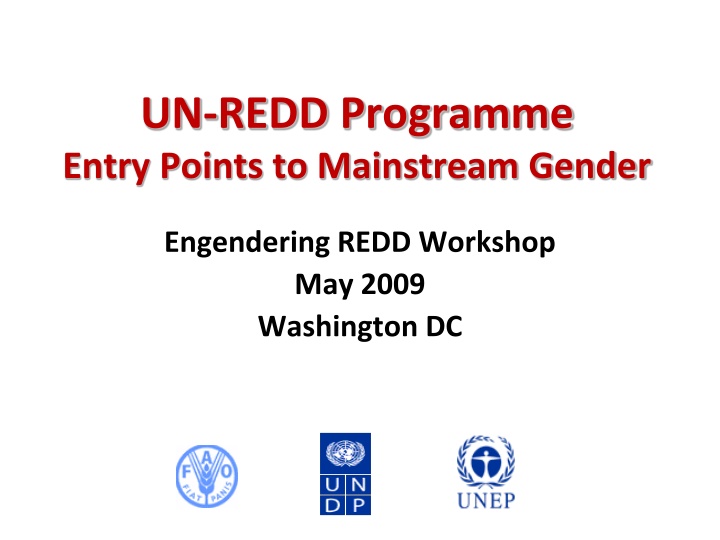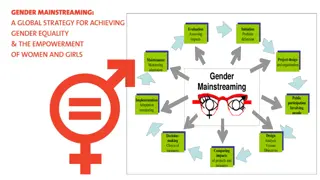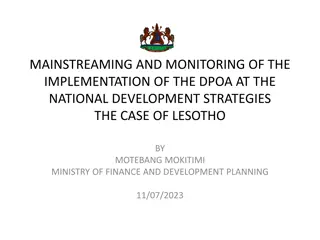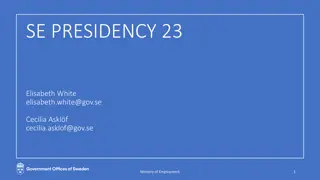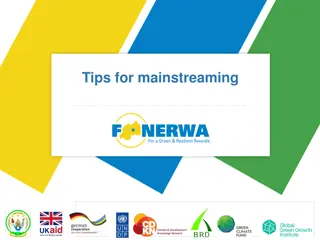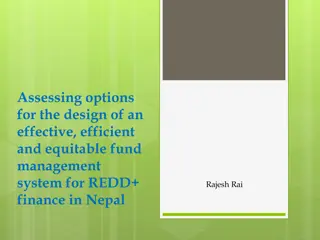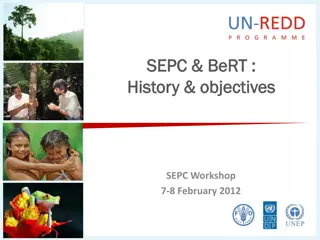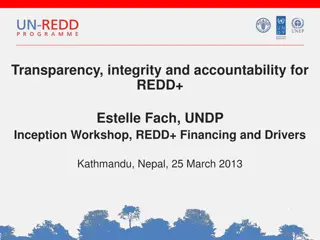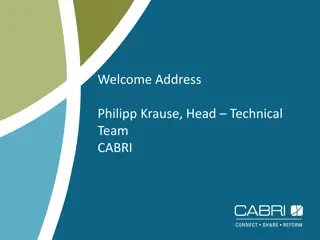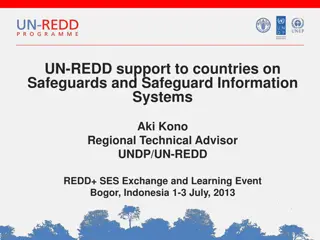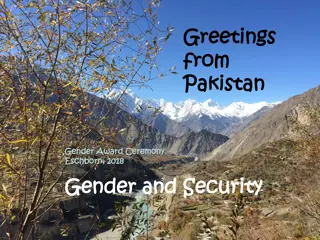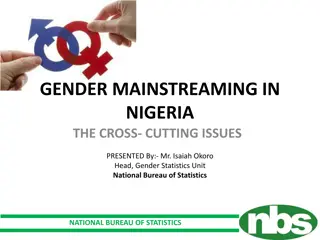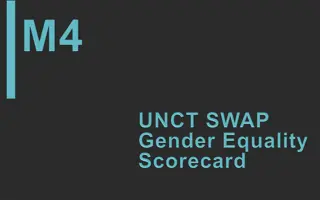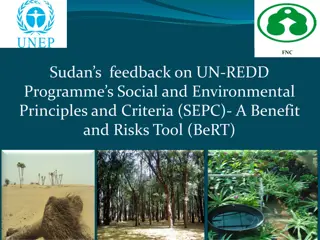UN-REDD Programme: Advancing Gender Mainstreaming in REDD Initiatives
The UN-REDD Programme aims to assist forested developing countries and the international community in implementing REDD initiatives effectively while promoting gender equality and empowering local communities. This workshop in Washington D.C. discusses the importance of mainstreaming gender considerations across various aspects of REDD projects. Key principles, pilot countries, and entry points for gender mainstreaming are highlighted, emphasizing the program's focus on capacity development, governance, and sustainable results.
Download Presentation

Please find below an Image/Link to download the presentation.
The content on the website is provided AS IS for your information and personal use only. It may not be sold, licensed, or shared on other websites without obtaining consent from the author.If you encounter any issues during the download, it is possible that the publisher has removed the file from their server.
You are allowed to download the files provided on this website for personal or commercial use, subject to the condition that they are used lawfully. All files are the property of their respective owners.
The content on the website is provided AS IS for your information and personal use only. It may not be sold, licensed, or shared on other websites without obtaining consent from the author.
E N D
Presentation Transcript
UN-REDD Programme Entry Points to Mainstream Gender Engendering REDD Workshop May 2009 Washington DC
Rationale of UN-REDD Programme To assist forested developing countries and the international community gain experience with REDD and thereby contribute to the UNFCCC post-2012 process To assess how REDD payments can create the incentives to ensure actual, lasting, achievable, reliable and measurable emission reductions, while benefiting people and maintaining other ecosystem services forests provide. 2
What is the UN-REDD Programme? Partnership of FAO, UNDP & UNEP to: (i) Assist developing countries to address capacity development, governance, and technical needs to support effective participation for REDD Support dialogue and consensus for methodologies for REDD: - Monitoring, Reporting, Verification - Stakeholder Engagement - Benefit Sharing - Carbon Accounting - Multiple Benefits - Payment Mechanisms (ii)
Pilot Countries Africa Congo, Tanzania, Zambia Democratic Republic of the Asia & Pacific Vietnam Indonesia, Papua New Guinea, Latin America & Caribbean Bolivia, Panama, Paraguay 4
Key Principles One country-driven, national program (that builds on existing processes of UNFCCC, World Bank, GEF, etc. and includes civil society and IPs) Focus on Governance and Local Empowerment Guided by the five inter-related principles of the UN Development Group (UNDG): o Human-rights-based approach o Gender equality o Environmental sustainability o Results-based management o Capacity development 5
Entry Points to Mainstream Gender 1. Mainstreaming across readiness components : monitoring indicators Payment structuring Benefit sharing arrangements Stakeholder participation processes 2. Operational Guidance on the Engagement of Indigenous Peoples and other Forest Dependent Communities 3. Civil Society Advisory Group 4. Civil Society Representatives on the Policy Board
REDD Action Phases National REDD Strategy Readiness Capacity Building & Institution Strengthening Large scale Investment Programmes Performance-based mitigation payments
Components of National Readiness Management of Readiness Stakeholder Participation REDD Implementation Framework National REDD Strategy Development Reference Scenario National Carbon MRV System 8
Components of National REDD Readiness MANAGEMENT OF READINESS Line Ministries & Departments Consultative process Communication Plan Statutory Bodies & Institutions National REDD Strategy National REDD Working Group House of Chiefs NGOs, CSOs, private sector Experts, other key stakeholder Lessons learned Mapping of relevant initiatives Status of information 9
Components of a national REDD regime REDD IMPLEMENTATION FRAMEWORK Analysis of resource and carbon ownership Identification of REDD beneficiaries Agreed allocation framework Analysis of national legislative framework Credible and transparent REDD framework Analysis of policy and institutional arrangements 10
STAKEHOLDERS PARTICIPATION Components of a national REDD regime Refinement and endorsement of REDD priorities at provincial/ district level National REDD Working Group REDD benefit sharing Stakeholder involvement National REDD strategy Baseline surveys 11
Example National Joint Programme Outcomes Strengthened multi-stakeholder participation and consensus at national level Successful demonstration of establishing a REL, MARV and fair payment systems based on the national REDD architecture Capacity established to implement REDD at decentralized levels National governance framework and institutional capacities strengthened for REDD Improved capacity to manage REDD and provide other forest ecosystem services at district and local levels
IP & Forest Community Guidelines for UN-REDD Programme Representation On Policy Board & National Committees Independent Civil Society Advisory Group Transparency & Access to Information Access to reports & official documents Primers & guidance for IPs on REDD Participation in relevant IP-led conferences Consultation documents co-developed with IPs Distribution of annual reports to IP networks Participation & Inclusion Fora for IP perspectives in REDD dialogue National participation & engagement strategy Activities & budget allocations in national programs Assessment of activity impact on IP rights Accountability Concerns & complaints addressed through Secretariat and Resident Coordinator
UN-REDD Programme Governance Policy Board made up of 9 participating countries, donors, agencies, Indigenous Peoples, CSOs & observers Policy Board decisions made by consensus among members Informed by Independent Civil Society Advisory Group Supported by UN-REDD Programme Secretariat, staffed by partner agencies
Civil Society & IPs on the Policy Board Indigenous Peoples & Forest Dependent Communities: One full member (Chair of UNPFII invited) Three observers (one from each region), as selected by the regional caucuses to the UNPFII Civil Society: One full member Three observers Representatives will be from each of the three regions and one northern NGO. To be selected via a self selection process TBD
Civil Society Advisory Group To provide independent advice and guidance to the UN-REDD Programme in response to issues raised by civil society Initial membership: Committee of Conference on Rights, Forests and Climate (October 2008) (RRI, RFN, Tebtebba, Forest Peoples Prog, and others) Activities: Advice on self-selection process for civil society representatives to the policy board Host panel discussion on governance indicators at next policy board meeting (June) www.rightsandclimate.org
Making REDD work for Gender Equity International REDD negotiations and schemes must ensure compliance with international and national commitments on gender equality and equity, including CEDAW Ensure full participation and integration of women, from local and indigenous communities, in policy design processes Equitable access to, and distribution of, the economic benefits derived from forest services provided to mitigate climate change Promote equal access of women to land ownership and other resources Both women and men must be trained in methods to increase carbon sequestration through forestry technologies, etc. 17
Thank you! www.un-redd.net
Gender Concerns: REDD Market Mechanisms Can Exacerbate Existing Inequalities Women earn less, own less, have fewer capital assets, less land and fewer inheritance rights. Therefore they have less to sell and are less likely to be compensated for environmental services 19
Gender Concerns: REDD Market Mechanisms Demand Skills and Education Women also have less access to formal education than men and thus fewer formally acquired skills (e.g. languages), making it much harder for them to: o Engage in technical and legal negotiations on REDD o Have sufficient education to benefit significantly from REDD projects 20
REDD Opportunities: Gender Equity Women are powerful agents of change, as well as innovators in relation to environmental changes When women are supported to be active participants in response efforts, their role within family and community has been used to great advantage for communities 21
REDD Opportunities: Gender Equity Reward women for their biodiversity stewardship, especially regarding saving seeds and nurturing trees through targeted and effective public governance measures Ensure the effective enforcement of the UN Convention for the Elimination of All Forms of Discrimination against Women 22
Recommendations: Making REDD Work for Women, Indigenous Peoples & the Poor 23
UNDP Mandate: Civil Society The United Nations Charter (1945) -- We the people Agenda 21 commitment to Major Groups (1992) UN Millennium Declaration (2000) UNDP and CSOs: a policy of Engagement ( 2001 ) UNDP Policy on Engagement with Indigenous Peoples (2001) UN World Summit (2005) UNDP and CSOs: a Toolkit for Strengthening Partnerships (2006) UN Declaration on the Rights of Indigenous Peoples (2007) UN Development Group (UNDG) Guidelines, Action Plan (2008) UNDP CSO Advisory Committee and Liaison Committee on Indigenous Peoples (2001-2008) Upcoming UNDP Global Strategy to Strengthen Civil Society and Civic Engagement: Voice and Accountability for Human Development (2008) 24
UNDP Mandate: Gender 3 Decades of UN agreements addressing the links between environment, human rights and gender Since the 1979 Convention on the Elimination of All Forms of Discrimination Against Women (CEDAW) And most recently, the 2007 Global Gender and Climate Change Alliance (GGCA) [by UNDP, IUCN, UNEP, and WEDO] 25
UNDP Mechanisms to Advance Gender Equity 1995 HDR GDI (gender-related development index) and the GEM (gender empowerment measure) UNDP Gender Programme Team UNDP close partnership with the UN Development Fund for Women (UNIFEM) 26
Making REDD Work for the Poor Poverty-Environment Partnership (PEP) Recommendations: 1. Information provision and access 2. Provision of upfront payment to encourage participation 3. Use of soft enforcement and risk reduction measures 4. Prioritize pro-poor REDD policies and long time horizons 5. Provide technical & legal assistance to national & local government, NGOs, and the private sector 6. Maintain flexibility in design of REDD mechanisms 7. Clear definition and equitable distribution of carbon rights 8. Development of social standards & application of existing standards to REDD systems 9. Apply measures to improve equity of benefit distribution 10.Alignment with international and national development strategies 27
What is REDD? REDD = Reducing Emissions from Deforestation and (forest) Degradation An international financial mechanism providing payments for reducing greenhouse gas emissions associated with deforestation and degradation in developing countries UN-REDD Programme = A Collaborative Partnership between FAO, UNDP and UNEP
